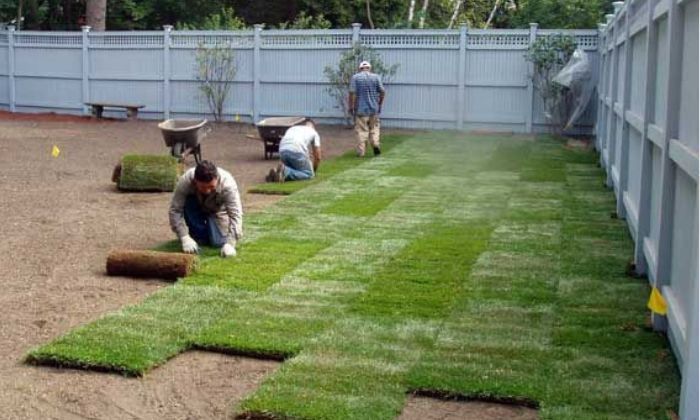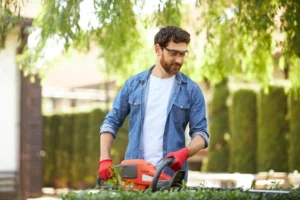Landscape grading is a foundational step in creating a well-balanced, functional, and attractive outdoor space. It involves reshaping and leveling the ground to control water flow, protect structures, and maintain soil health. Whether you’re improving drainage around your house, preventing soil erosion, or simply aiming for a better-looking lawn, landscape grading is essential to a successful landscaping project. In this guide, we’ll cover the importance of grading, various techniques, and provide practical advice for planning, executing, and maintaining a grading project.

What Is Landscape Grading
Landscape grading is the process of shaping the land’s surface to create a level or sloped base for landscaping, construction, or drainage purposes. It involves the movement and manipulation of soil to ensure proper water flow, prevent erosion, and enhance usability.
Grading typically prepares the ground for features like lawns, gardens, patios, or structures. Proper grading directs water away from foundations, minimizing flooding and damage. The process requires tools like bulldozers or graders and may involve adding or removing soil. Landscape grading is crucial for creating aesthetically pleasing, functional outdoor spaces while protecting property from water-related issues.

Why Landscape Grading Is Important
Effective landscape grading has numerous benefits that go beyond just aesthetic appeal. Here’s why homeowners should prioritize grading as part of their landscape design:
Drainage Control
Proper yard grading directs water away from structures, preventing puddles and water accumulation near foundations. This reduces soil erosion, which can harm landscaping and destabilize soil. Effective grading controls water runoff, helping to prevent foundation damage and extending the lifespan of your property. By managing drainage, landscape grading protects your yard’s structure and enhances its durability, creating a more stable and resilient outdoor space.
Foundation Protection
Proper grading is essential for protecting your home’s foundation. It slopes the ground away from the structure, guiding water away to prevent buildup around the foundation. Without this, poor drainage can allow water to seep into basements or crawl spaces, leading to damp conditions ideal for mold growth, mildew, and even structural damage. Over time, unchecked water exposure may erode the foundation and cause cracks, impacting the integrity and safety of the building. Effective grading and drainage prevent these issues, helping to preserve your home’s foundation and avoiding costly repairs.
Soil and Plant Health
Landscape grading and drainage improvements are vital for soil and plant health. Proper grading ensures soil drains well, which prevents waterlogging and supports strong root growth. Well-drained soil holds nutrients better, minimizing runoff that can wash away essential minerals plants need to thrive. By creating these optimal conditions, grading helps maintain nutrient-rich soil, promoting healthier plants, lawns, and gardens.
Enhanced Aesthetics
Landscape leveling and grading improve the aesthetics of a yard by creating a smooth, even surface that looks polished and inviting. By eliminating uneven or bumpy areas, grading gives the landscape a clean, organized appearance. It also allows you to highlight specific features, such as flower beds or pathways, adding depth and visual interest to the design. Proper grading can create natural contours, making your landscape more dynamic and attractive. This transformation enhances curb appeal, making the outdoor space both functional and visually appealing, ideal for enjoyment and showcasing the beauty of your property.
Types of Landscape Grading
Understanding the different types of landscape grading is essential when planning your project. Here are the most common techniques:
Positive Grading
Positive grading is the practice of shaping the ground around buildings to slope outward, directing water away from foundations and toward designated drainage areas. This technique helps prevent water accumulation near structures, reducing the risk of basement leaks, foundation damage, and soil erosion. By ensuring that rainwater or runoff flows away from the building, positive grading promotes better drainage and safeguards against moisture-related issues. Implementing a positive grade is a fundamental part of landscaping and construction, protecting buildings from water damage and enhancing long-term stability. Proper grading supports both the property’s integrity and the surrounding environment.
Negative Grading
Negative grading occurs when the ground slopes toward a building, rather than away from it. This creates the potential for water to pool around the foundation, which can lead to serious issues like moisture damage, mold, and structural weakening over time. Proper grading ensures that water flows away from the building, reducing the risk of water infiltration and foundation damage. If negative grading is present, it should be corrected by regrading the land to create a slope that directs water away from the foundation, protecting the integrity and longevity of the building.
Flat Grading
Flat grading involves leveling the ground to create a smooth, even surface, typically for lawns, patios, or garden beds. This process ensures that the area is uniformly flat, promoting an aesthetically pleasing and functional outdoor space. However, while flat grading provides a stable foundation, it’s crucial to include proper drainage systems to prevent water from accumulating. Without adequate drainage channels, water can pool on the surface, potentially damaging plants, patios, or lawn areas. Therefore, while leveling is key, managing water flow is just as essential for the long-term durability and health of the landscape.
Terraced Grading
Terraced grading involves creating step-like levels on steep slopes, often used in landscaping and agriculture. This technique helps prevent soil erosion by slowing water runoff, allowing the ground to absorb moisture more effectively. It also improves stability on hillsides, reducing the risk of landslides. In addition to its functional benefits, terracing enhances the visual appeal of a landscape, creating distinctive, multi-level surfaces. It can be used for planting crops, gardens, or simply as an aesthetic feature in areas with significant slopes. Terraced grading is commonly seen in mountainous regions and on hillsides in urban landscapes.
Steps to Plan and Design a Grading Project
Planning is key to a successful grading project. Follow these steps to design an effective landscape grading plan:
Assessing the Landscape
Assessing the landscape involves thoroughly evaluating the layout of the area, including slopes and drainage patterns. Start by identifying areas where water tends to accumulate, as this could indicate poor drainage. Look for uneven surfaces or low spots that might cause water to pool. Pay attention to areas prone to soil erosion, which can be exacerbated by improper drainage or slopes. This assessment helps determine potential problem areas that require attention, such as correcting uneven surfaces, improving drainage, or adding erosion control measures to ensure a more stable and functional landscape.
Creating a Grading Plan
Creating a grading plan involves designing the land’s surface to ensure proper drainage and water flow. Start by outlining the slope angles and elevations of the area to manage water runoff effectively. Identify areas that need positive grading, where the land should slope away from structures to prevent water accumulation. Additionally, determine if extra slopes are necessary in certain areas to optimize water flow, directing it toward proper drainage systems. The plan should provide clear guidelines on soil grading, drainage ditches, and elevation adjustments to prevent flooding or water-related issues on the property.
Choosing Equipment
When selecting equipment for grading a landscape, the size and scope of the project are key considerations. For larger projects, heavy machinery like skid steers or mini-excavators may be necessary to efficiently move large amounts of soil. However, smaller yards or simpler tasks can typically be managed with basic tools such as shovels, landscaping rakes, and wheelbarrows. It’s important to choose tools that are suited to the scale of your project to ensure efficiency, accuracy, and safety. Proper equipment selection will help achieve the desired grading results with minimal effort and time.
Considering Local Regulations
Before starting any yard grading project, it’s crucial to check local regulations, especially regarding water runoff management. Many areas have specific rules about how water should be redirected to prevent flooding or erosion. Failing to comply with these regulations can result in fines or forced removal of work done. Contact local authorities, such as the zoning or building department, to get guidance on required permits or restrictions. Ensuring your grading project is compliant with these regulations helps protect your property, the environment, and avoids legal issues down the line.
DIY vs. Professional Landscape Grading
DIY grading is suitable for small projects like minor regrading or drainage solutions in a backyard. It’s cost-effective but requires proper equipment and careful planning. On the other hand, professional landscape grading is ideal for larger or more complex projects. Experts ensure precise slope grading, essential for proper drainage and preventing long-term issues. While DIY can work for simpler tasks, hiring professionals saves time, reduces errors, and ensures quality results, especially for large or intricate yards that require specialized knowledge and equipment. Ultimately, the choice depends on project size and complexity.
How to Grade a Landscape for Optimal Drainage
Follow these steps to create effective drainage for your landscape:
Setting Up Slopes
Setting up proper slopes around your yard is essential for water drainage. A general rule for yard grading is to slope the soil away from structures like your home’s foundation at an angle of at least 2-3%. This gentle incline helps direct rainwater or runoff away from the foundation, preventing water accumulation, which can lead to issues like basement flooding or soil erosion. Ensuring the ground slopes correctly can protect the integrity of your home and maintain a stable foundation, promoting long-term structural health and preventing costly repairs due to water damage.
Creating Drainage Channels
Creating drainage channels is essential to manage water flow and prevent flooding in areas with heavy runoff. To achieve this, you can use gravel or trench drains, which direct the water away from vulnerable spots. These drainage solutions can be discreetly integrated into the landscape, ensuring they blend seamlessly with the surroundings. Whether it’s for a garden or driveway, the design can be customized to suit aesthetic preferences. Properly designed drainage channels not only protect your property but also enhance the overall landscape design, adding both functionality and visual appeal.
Adding Soil and Leveling
To add soil and level the ground, start by building up soil in areas that require it, adhering to the grading plan for the desired height and slope. Use a rake or shovel to spread the soil evenly across the area. After spreading, regularly check the slope using a level or other measuring tool to ensure the surface is accurate and consistent. Adjust the soil as needed to maintain proper drainage and achieve the correct slope. This process ensures a smooth, even surface, essential for landscaping construction projects.
Compacting Soil
Compacting soil is an essential process to ensure stability and prevent future settling or unevenness in graded areas. By compressing the soil, you eliminate air pockets and increase its density, making it more solid and less prone to shifting. This can be done using a tamper (for smaller areas) or a roller (for larger spaces), both of which apply pressure to the soil surface. Proper compaction creates a firm foundation for construction projects, such as paving or building, ensuring long-term durability and reducing the risk of uneven surfaces over time.
Common Mistakes in Landscape Grading and How to Avoid Them
Common mistakes in landscape grading can disrupt drainage and plant health. First, improper sloping can cause drainage issues; always measure and maintain the correct gradient. Insufficient compaction of soil may result in settling, affecting your grading plan and drainage ensure thorough compaction. Ignoring local drainage laws can lead to legal problems, especially if grading affects neighbors or community systems. Lastly, overlooking plant needs, such as soil depth and moisture levels, can hinder plant growth. Avoid these pitfalls by planning carefully to maintain an effective and sustainable landscape grading design.
Why Choose Lakota Design Group for Landscape Grading
Lakota Design Group specializes in landscape grading, offering expert solutions for residential yards, gardens, and complex landscaping projects. With a commitment to precision, we ensure that your landscape grading meets both aesthetic and functional needs. Our team has the experience to handle everything from initial design to final compaction, making your grading project seamless and professional.
Conclusion
Landscape grading is an essential step in creating a functional and beautiful yard. Whether you choose to do it yourself or hire a professional, proper planning, grading techniques, and maintenance will ensure your landscape remains healthy and attractive for years. From preventing foundation issues to enhancing soil health, investing in quality grading will pay off in the long run.
Frequently Asked Questions
What is grading in the landscape?
Grading in landscape refers to reshaping the ground to control water flow, improve drainage, and create a stable base for landscaping features.
Can I regrade my yard myself?
Yes, for small areas and minimal grading needs, DIY grading can be effective. However, for larger or more complex projects, professional help is recommended.
How to grade the landscape away from the house?
Ensure there is a slope of at least 2-3% away from the foundation. Create drainage channels to direct water effectively.
How do you calculate landscaping grades?
Measure the slope angle using a level and measuring tape. The slope should drop approximately 1 inch for every 12 inches of horizontal distance.
Is it expensive to level a yard?
The cost varies depending on the size and complexity of the project, the equipment required, and whether you opt for professional services.





